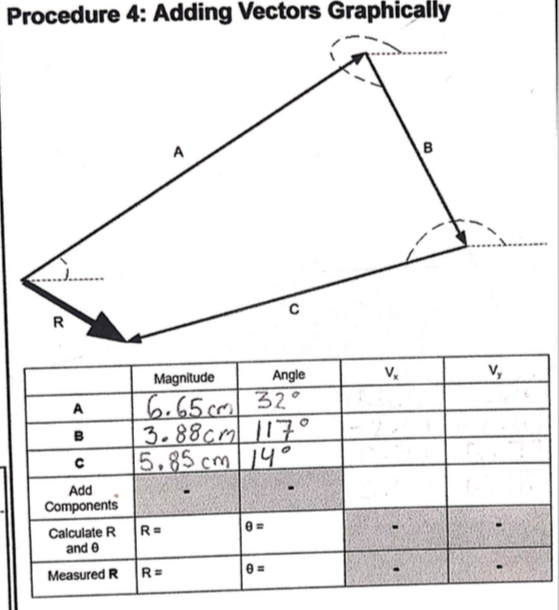Procedure 4: Adding Vectors Graphically R Magnitude Angle V. V, 32° 6,65 cm 3.88cm l17° 5.85 cm14° A в Add Components Calculate R and e R= Measured R R=
PLEASE HELP FILLING OUT TABLE.
Procedure 4: Adding Vectors Graphically
If you use a ruler and a protractor to draw a series of vectors to scale, the resultant will run from the beginning of the first vector to the end of the last vector.
-
In the picture below, measure the lengths and angles of vectors A, B and C and record these in the 2nd and 3rd columns on the datasheet. Remember to measure angles CCW from the positive x axis.
-
Using cos and sin, calculate the x and y components of vectors A, B and C and record these in the last two columns on the datasheet.
-
Add the x components in the next-to-last column and the y-components in the last column
- Use Pythagorean Theorem and ArcTan to calculate the magnitude and direction of R
-
Measure the length and angle of vector R
- Confirm that these two measurements of R match
"Fixing the angle"
After you do the "four step method" to add vectors, you sometimes have to "fix the angle". Remember that we always start measuring an angle from horizontal to the right (or the positive x-axis). and that we always measure counter-clockwise.
When we do step 4: φ = tan-1(Ry / Rx) , we get an angle between 0 and 90, However, if the resultant lies in the 2nd, 3rd or 4th quadrant then we have to "fix the angle".
- First figure out which quadrant the resultant should be in. The signs of the answers to step 1 and step 2 will give you this. For example:
- if the answer to step 1 is -34 & the answer to step 2 is -17, then the resultant starts at the origin and moves to the left and down. That puts the resultant in the third quadrant.
- In the picture below, the green line, which represents the resultant, moves to the left and down, into the third quadrant. Notice the thin green arc starts at the positive x-axis and runs counter-clockwise around to the green line.
- Pretend that when you do step 4, and take the arctan, the answer is, say, 30 degrees. Clearly the angle marked by the thin green arc is more than 30 degrees, so we need to "fix the angle"
- Any time we end up in the third quadrant, the fix is to add 180 degrees to the answer we got by taking the arctan
- All four fixes are shown in the picture

Trending now
This is a popular solution!
Step by step
Solved in 2 steps






